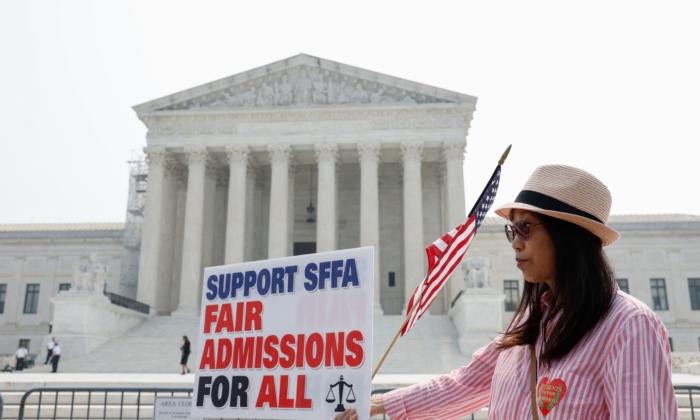The Supreme Court of the United States (SCOTUS) hasn’t given conservatives a straight flush.
Chief Justice John Roberts and Justice Brett Kavanaugh broke ranks with their conservative confrères in the so-called voter rights case in Alabama.
I say “so-called voter rights case” because, in fact, it had nothing to do with the law, which stipulates that everyone, black or white, be granted free access to the ballot.
No, that was a mere cover for the real purpose of the case, which was to find a way to create more Democratic districts.
The court stated that there had to be more black districts constructed.
But a black district is, as a matter of fact, a Democratic one. QED.
Let’s draw a veil over that unfortunate decision and celebrate two more recent ones: the (pardon) “so-called” affirmative action case and the student loan case.
Let’s take the second one first.
The easiest way to understand what just happened is to begin by understanding what the word “loan” means.
To do that, you also have to understand what the word “debt” means.
This is a harder one for Americans because it has been some years since they have had to come face to face with a real, live debt.
What I mean is this: In the real world, when someone lends you money, you incur a debt.
The cheerful, pink-unicorn aspect of that event comes at the beginning.
The money you snag looks exactly like unencumbered cash.
You can do whatever you like with it: buy a car, take a trip, go to college.
There’s one important difference between debt and cash, however.
If you happen to have a sock full of cash, you can spend it however you like and that’s the end of the story.
Loans come with a concluding chapter, which is often more melancholy than the opening chapters.
Because with a loan, in the end, you have to pay it back.
This used to be widely understood.
At some point along the way to utopia, general appreciation of this unpleasant fact failed.
There are doubtless deep cultural reasons for this failure, but in the present context, the relevant issue is that thousands upon thousands of young people incurred debts that they didn’t want to pay.
They wanted you, the taxpayer, to pay instead.
President Joe Biden thought this was a good idea.
Free money is always a vote-getter, even if it unfairly penalizes taxpayers.
But SCOTUS didn’t think that the president had the authority to shift the burden of $1 trillion in indebtedness from one part of the population to another.
(You keep hearing about debt “cancellation” and “student loan forgiveness,” but the burden of debt isn’t canceled, it’s merely shifted.)
This decision is good in about 57 different ways.
It’s fair to all those who took out student loans and acted like responsible adults by paying them back.
More generally, it’s a small nudge in the direction of fiscal responsibility.
Perhaps it'll even prompt more people to ask why the federal government should be in the business of providing or subsidizing student loans at all.
That last thought is a big one that we can leave for another day.
For now, let’s return to my second “so-called,” “so-called affirmative action.”
What it really is, as any honest observer will admit, is racial and sexual discrimination proceeding under the cover of a merely rhetorical anti-discrimination.
Indeed, the history of affirmative action is a history of great ingenuity expended to evade the announced purpose of the practice: fostering equality.
Time and again, the rhetoric of equality is deployed as a smokescreen to pursue ends that are patently inequitable.
In the beginning, affirmative action was undertaken in the name of equality.
But, as always seems to happen, it soon fell prey to the Orwellian logic by which the principle that “all animals are equal” gives birth to the transformative if contradictory codicil: “but some animals are more equal than others.”
Affirmative action is Orwellian in a linguistic sense, too, since what announces itself as an initiative to promote equality winds up enforcing discrimination precisely on the grounds that it was meant to overcome.
Thus, we’re treated to the delicious, although alarming, contradiction of college applications that declare their commitment to evaluate candidates “without regard to race, gender, religion, ethnicity, or national origin” on page one and then helpfully inform you on page two that it’s to your advantage to mention if you belong to any of the following designated victim groups.
The whole history of affirmative action is instinct with that irony.
The original effort to redress legitimate grievances—grievances embodied, for instance, in the discriminatory practices of Jim Crow—has mutated into new forms of discrimination.
In 1941, President Franklin Roosevelt established the Fair Employment Practice Committee because blacks were openly barred from wartime factory jobs.
But what began as President John F. Kennedy’s executive order in 1961 directing government contractors to take “affirmative action” to assure that people be hired “without regard” for sex, race, creed, color, and so forth has resulted in the creation of vast bureaucracies dedicated to discovering, hiring, and advancing people chiefly on the basis of those qualities.
White is black, freedom is slavery, “without regard” comes to mean “with regard for little else.”
Moreover, it’s worth stressing, the inequities are double-sided.
Not only are blacks and Hispanics given preferential treatment, but also whites and (especially) Americans of Asian descent are actively discriminated against.
Think about this: “An Asian American applicant in the fourth-lowest decile has less than a 1 percent chance of being admitted. But an African American applicant in the fourth-lowest decile has a 12.8 percent chance of being admitted.”
Why? Because they’re Asian American. There’s no other reason.
In this respect, Asians are the new Jews, excluded on account of their ethnicity and subject to unofficial quotas wherever official quotas are banned.
In some ways, our situation is a cautionary tale about the dangers of ingenious legal hermeneutics fueled by progressive sentimentality and expansionist government bureaucracy (is there any other kind?).
After all, the Leviathan of affirmative action and what has been aptly called the “racial spoils system” and the diversity conglomerate it supports have emerged from a small cluster of legal imperatives.
The 14th and 15th Amendments to the Constitution provide for “due process” and “equal protection” and stipulate that one is equal under the law and entitled to vote regardless of one’s skin color.
The Civil Rights and Voting Rights Acts from the 1960s are essentially glosses or restatements or extensions of those amendments.
The road from those noble and straightforward desiderata—don’t discriminate against people because of their race or national origin—to such monstrosities as the smorgasbord of “Minority-Serving Institutions” programs is clear and direct.
The covert, or semi-covert, political agenda is only too obvious.
Blacks vote overwhelmingly—more than 90 percent—for Democrats.
Hence, as I mentioned above, the effort to gerrymander on the basis of race is simply to use the imperatives of the Voting Rights Act as a cover for creating Democrat-controlled fiefdoms.
The Supreme Court just knocked a hole in this.
Naturally, the left is screaming, vowing that it'll find ways around the law.
I have no doubt that they'll be at least partly successful.
But people keep telling me that the pendulum of racial grievance-mongering must eventually start to swing back toward normality.
The Court has just given it a big push in that direction.





